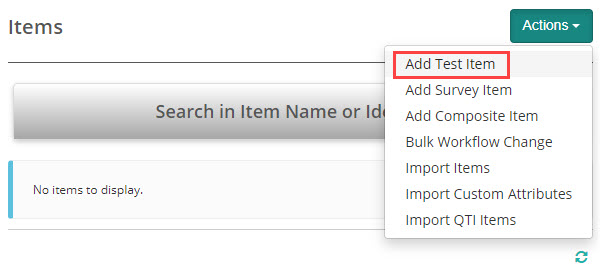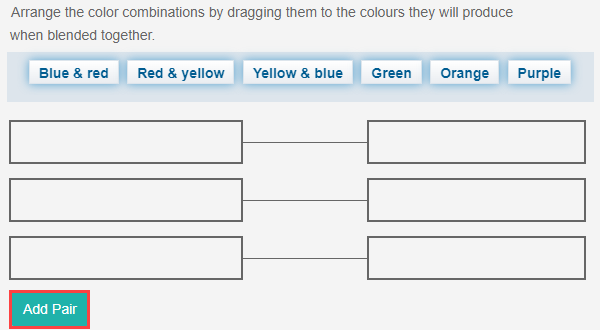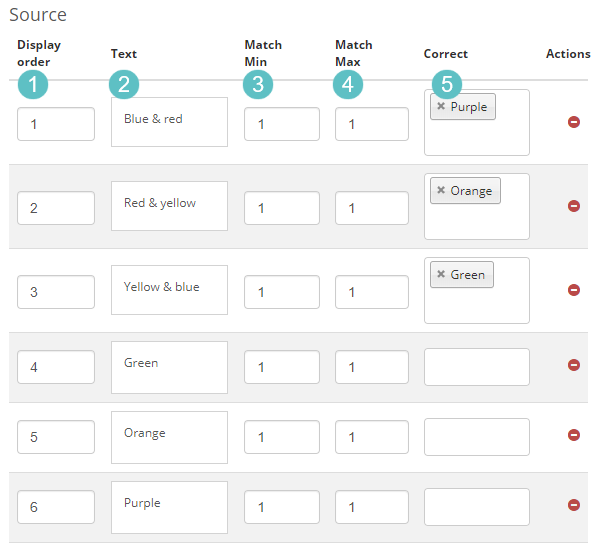Welcome to the Janison Insights help portal
Item types
An associate interaction item type involves matching or associating different items or concepts with each other. In this item type, you are given a list of items or statements and asked to match them with their corresponding pairs from another list. Items can be created as images, text or a combination of both.
Our practice test to the right covers different use-cases of this item type.
In the screen captures below you can view an example of an associate interaction item type, we’ve used images for the content of the item.

Associate interaction practice test
Open this test in the Janison test player and complete three examples of the associate interactions items.
Read more

Move to the next slide to see the completed item.

Check out our associate item video tutorial or follow the steps below the video to learn how to create an item.
Navigate to Author > Items.

Select Add Test Item from the Actions drop-down.

The New Test Item screen displays.
Complete the form as required. Below is an example of an new item we created.
Select Associate Interaction as the item type.

The rows that display for the responses are determined by the number you enter into Min Associations. In the example below, we have entered 3 which displays as the three highlighted fields.

The Max associations value must be equal to or higher than the Min associations value. If the value is higher, an Add Pair button becomes available to the test-taker, and they will have the option to add pairs to the value set for the max associations. In the below example we have set the max associations as 4, to make the Add Pair button display. In this case, it doesn’t make sense to have the button available.

The Add Pair option is useful if for example, you don’t want to give any clues regarding the number of matches that are available. You could have just a single row and ask the test-taker to make as many matches as possible. In this example we have set the min associations to 1 and the max associations to 3. Here is how this would look.

The Add Pair button is not visible once the max associations are reached. This gives the test-takers the cue that they have reached the limit.
If you wish to add a level if difficulty, you could set the max associations higher than the options available, that way the Add Pair button would still be visible, taking that cue away.
In this section you’ll enter the responses.

Match Min – The match min must be lower than the match max.
Match Max – if you set match max to ‘1’, the test-taker can only match the text or images in the top drag region to one option below. The text or image will no longer display in the top drag region once the match max number is reached. If set to 2, the text or images can be matched twice.
In the below example we have set the match max for Greenhouse gases to 3 and each of the gasses to 1. Greenhouse gasses remains available for selection in the top list, while Carbon dioxide is no longer available for selection. This gives the test-taker cues as to how many times they can select each option. Test authors could set the max matches higher to take those cues away.

Associate interaction item types are system marked.
There are two scoring types available, correct/incorrect and per distractor.

Correct/Incorrect
With this scoring type, the test-taker must select all correct responses to get the item correct.
Per distractor
With this scoring type, additional scoring options will become available to the item author, allowing them to add a score for each response.
Min Score – Setting a value in this field will determine the minimum score that the system can assign to the item.
Max Score – Setting a value in this field will determine the maximum score that the system can assign to the item.
Default Value – The system will use this value if a row doesn’t have a value in the Score column.

A scoring section becomes available below where item authors can set a score per distractor.

1300 857 687 (Australia)
+61 2 6652 9850 (International)
ACN 091 302 975
ABN 35 081 897 494
© 2024 Janison
Janison acknowledges the traditional owners of the land on which we work and meet. We acknowledge the continuous care of the land, animals and waterways. We pay our respects to Elders past, present and emerging.